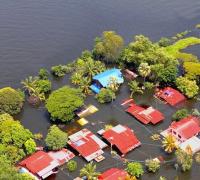Climate financing must impact locally
In Vietnam, the rainy and dry seasons are increasingly unpredictable. Such climate changes have a greater impact in Vietnam than, for example, in Denmark. Many in Vietnam live off the production of rice and other crops, and their livelihoods are dependent on fixed seasons.
Local governments are actively trying to address such changes and resulting challenges with more accurate seasonal forecasts, different crop varieties and more effective water management. However, they are often limited by shortage of funds. This is just one of many examples illustrating both the need for securing adaptation in poorer countries and local governments’ key role in implementing adaptation.
The need for climate change adaptation is exacerbated by the fact that we are not on track to limit the average rise in global temperature to 2 degrees Celsius and thereby limit the extent of climate changes. Developing countries will experience the consequences most acutely as climate changes will be more severe in their geographical areas, but also because poorer countries often lack strong institutions and infrastructure which can deal with physical impacts of climate changes.
Adaptation at the local level
The current discussion around adaptation revolves around how much money will be set aside to address climate changes. Yet more focus should be given to directing financing to local levels to support adaptation on the ground.
Our research shows that local governments in poorer countries are actively trying to address climate changes, but are limited by funding shortages. At the same time, local authorities often have the competencies necessary to address local impacts of climate changes. They are generally responsible for local water management, support to local agriculture and local disaster preparedness and response as well as other matters integral to climate change adaptation.
The majority of adaptation funding should therefore be dispatched directly to the local level. It is there the need for adaptation financing is greatest – not at national ministries or in parliaments.
Such an approach does not preclude central governments’ involvement in decisions on the allocation or applications of climate financing, which could be achieved through national climate change adaptation plans. Neither does it prevent the use of some adaptation financing to support such national planning processes or programs. It does ensure, however, that the majority of adaptation funding reaches the local areas where people struggle daily with the effects of climate changes.
Local changes require local expertise
This approach is also best suited to addressing climate changes as such changes and their effects are dependent on local conditions. Dry spells in one area can have an entirely different impact than in an adjacent area where there are different industries or crops.
Even within a single geographical area, the effects of climate changes are not uniform. When interviewed on local climate changes last year, a district level official in central Vietnam noted that it was difficult to pinpoint only a few climate changes since there were so many diverse climate change impacts in the area. These ranged from temperature changes to shifting seasons to changing precipitation patters and water levels, all with their own array of effects on local livelihoods and development.
Because the impacts of climate changes are so localized, local governments are better positioned to respond than national officials. Local administrators are most knowledgeable about local conditions and needs, and are on the front lines of the struggle to adapt to climate changes.
Successful experience with local approaches
A locally-oriented approach has been tested – with success – by UNCDF, the UN’s Capital Development Fund. UNCDF has provided support to local governments in developing countries for decades in a wide array of sectors, including education, water and infrastructure.
Furthermore, Kenya has now demonstrated that a locally-oriented approach can also be successful in climate change adaptation. Kenya’s central government, in cooperation with international development organizations, created a mechanism for decentralizing climate financing and planning. After multiple pilot projects, this approach will be incorporated into their National Adaptation Plan. The experience is there, and now it is a question of applying it in adaptation.
Incorporating the local now
It is essential we engage in this discussion now. Too much focus on the amount of financing for adaptation can easily distract from a discussion of how the funding is best utilized. And that is just as important.
There is a danger that climate negotiators at COP21 reach agreements that overlook the crucial role of local authorities in addressing climate changes, which would weaken adaptation before we even get started.
Without a focus on the front lines, where climate changes are a daily struggle, our international plans and initiatives will be impotent. Yet there is no time for failure.
DIIS Experts


